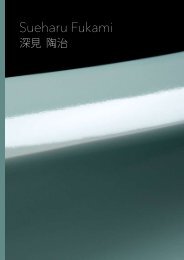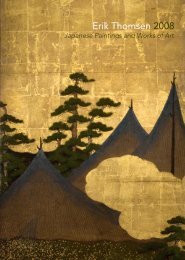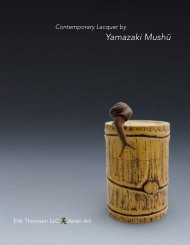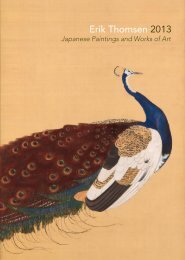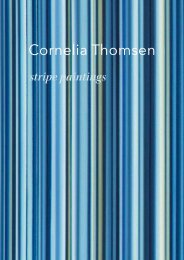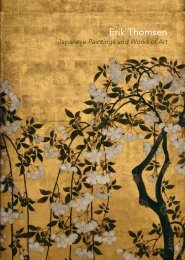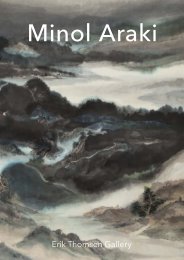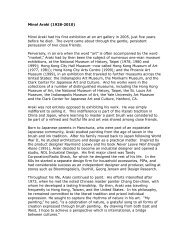View publication (pdf file 6.5 mb) - Erik Thomsen
View publication (pdf file 6.5 mb) - Erik Thomsen
View publication (pdf file 6.5 mb) - Erik Thomsen
- No tags were found...
You also want an ePaper? Increase the reach of your titles
YUMPU automatically turns print PDFs into web optimized ePapers that Google loves.
30Mikami Yōkōdō 三 上 楊 光 堂Writing Box with the Hundred KingsTaishō-Shōwa Periods, 1920s – 30sH 4 ½" × L 10 ¾" × W 8 ¼"(11.5 cm × 27.5 cm × 21.2 cm)Maki-e lacquer boxInscription on outer tomobako box:»Tebako Box with Images of the Hundred Kings«手 箱 百 王 之 図(end of box):»Tebako Box with Images of the Hundred Kings«手 筥 百 王 之 図(inside lids):»Made by Mikami Yōkōdō of Kyoto«平 安 三 上 楊 光 堂 造 之hundred plants 百 花 之 王 .« 1 Compositions thatdepicted both together were deemed auspiciousand were called the »Hundred Kings 百 王 « design,as they depicted the gathering of the respectiverulers of the animal and plant kingdoms.All outside edges are rounded and lacqueredin gold and red lacquer togidashi. The lid rims andthe two rings to hold rope are in solid silver. Theinside rims, including the suzuri ink stone rims arein silver lacquer; all other surfaces are coveredwith evenly sprinkled nashiji gold flakes. The suitekiwater dropper is in the shape of a butterfly and ismade of silver, shibuichi, shakudō, and inlaid gold.Seals:1) Mikami 三 上2) Yōkōdō 楊 光 堂On the inside of this fine stacked rectangular writingbox there is a compartment for writing paperabove which is a lipped tray to hold writing utensilsand a removable plate that stores the suzuri inkstone and suiteki water dropper.The outside décor is dominated by two dramaticshishi lions in gold, silver, red and black raisedtakamakie lacquer; they are surrounded by stylizedpeonies in gold and red lacquer togidashi on aroiro black lacquer ground. The design on this writingbox has an ancient Chinese origin. The legendaryshishi lions were called the »king of hundredanimals 百 獣 之 王 « and the peony the »king ofThe superb work was made by the lacquer workshopMikami Yōkōdō 三 上 楊 光 堂 , which underthe leadership of Mikami Harunosuke 三 上 治 助(1850 –1920) won many honors, both in Japan aswell as abroad. Objects from the workshop wonprizes at several international exhibitions, includingChicago in 1893, Seattle in 1896, and Hanoiin 1903. The son of the founder, Mikami Jisaburō三 上 治 三 郎 carried on the family tradition andwon a prize at the 1937 Paris exhibition. The artistsof the studio were attentive to international artmovements during its time of intensive interactionwith foreign fairs and it is therefore no surprisethat the present writing box bears signs of foreigninfluence in its design. Under the leadership ofMikami Jisaburō 三 上 治 三 郎 , the studio became aknown leader in introducing Art Nouveau styles toJapanese audiences in the 1920s, as documentedin the recent exhibition at the Tokyo NationalMuseum for Modern Art. 2A set of two nested double tomobako boxes weremade for the writing box, both of kiri-wood, theoutside one with lacquer. Both tomobako boxes aresigned and sealed by Mikami of the Yōkōdō Studio.100 101



